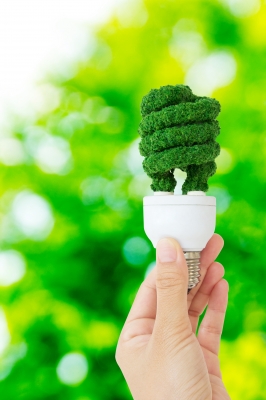
Jumping on the conservation bandwagon used to be seen as a fad, now people are realizing that energy efficiency has always been a necessity. Lighting, air leaks, and even your showerhead can be silently sapping energy while loudly making its presence known on your energy bill. To begin making, seeing, and feeling changes in your home’s energy usage, consider these 4 ways to make your home energy efficient.
Get rid of incandescent lighting
Incandescent lights bulbs, which have outlived their status as the standard bulb for lighting, are among the biggest energy leeches in the home. Among their many poor features, incandescent lights:
- Only reflect 10% light — that other 90% is all heat
- Have a short lifespan, lasting approximately 800 hours
- Power your home using 60-75 watts of power
Energy resourceful lightbulbs, like CFLs (compact florescent lamps) and LEDs (light-emitting diode) by comparison:
- Reflect 100% light
- Have a much longer lifespan from 10,000 hours (for CFLs) to 50,000 hours (for LEDs)
- Need only 13 watts of power
Savings
This one change, switching out incandescent lightbulbs with environmentally friendly models, will reduce the energy wasted on lighting your home by up to 80%.
Seal electrical outlets
Air leaks are deceptively raising your energy bill. They are sometimes hard to locate, and at times air leaks come from sources that you may not expect — electrical outlets, for one, are a source that can be easily overlooked.
Outlets that are not in use (and even the hole under electrical outlet covers) can easily be sealed using items such as child-proofing caps and foam outlet gaskets.
Savings
Heating and cooling account for 43% of the energy used in a home (with the percentage going up or down based on factors like climate, etc.). A home that is properly insulated can shave off 20% or more from your energy bill.
Weatherstrip doors and windows
If the sun shines through your closed doors, you have an insulation problem. Doors and windows with cracks/gaps allow air, dust, and even bugs to infiltrate your home. To add insult to injury, these openings contribute to the rise in your energy bill. They cause the home to experience inconsistent temperatures, and as a result you go back and forth between lowering and raising the thermostat — while it raises your energy bill. To be more specific: poorly insulated doors account for 11% of the energy lost in your home, while poorly insulate windows account for 10-25%!
Weatherstripping doors and windows is an energy efficient, cost-effective, DIY solution to sealing. There are different types of material used for weatherstripping, mainly dependent on where the stripping will be used, like sliding window, door bottom, etc. The varieties include:
- Door sweeps (The most common size is a 36 inch door sweep but you may need a 42 inch door sweep).
- Foam
- Rolled or reinforced vinyl
- Tape, and
- Tension seal
Install low-flow showerheads
Low-flow showerheads are easily one of the most energy conserving products that your home will benefit from immediately. Low-flow showerheads offer the same or better quality of shower while saving energy and money.
Modern showerheads can use 2.5 gallons of water per minute, (GPM) while earth showerheads only use 1.5 GPM.
Savings
Low-flow showerheads use less water and therefore less heat. Installing earth showerheads allow for as much as 30% in water savings along with lowering energy costs.
By sealing air leaks and making the switch to more energy efficient lighting and showerheads, you’ll quickly gain comfort in your home and bank account.
